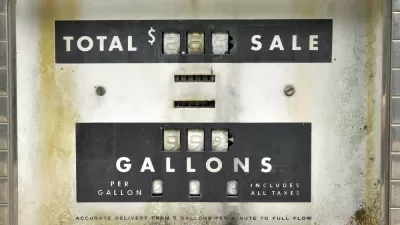Oil independence, a goal set by President Nixon in the depth of the 1973 energy embargo, was achieved in the last week of November thanks to a fluke in record keeping as well as an "unprecedented boom in American oil production."

"America turned into a net oil exporter last week, breaking almost 75 years of continued dependence on foreign oil and marking a pivotal -- even if likely brief --moment," reported Javier Blas, chief energy correspondent for Bloomberg News, on Dec. 6 in a story widely replicated across media outlets that report on energy data.
The shift to net exports is the dramatic result of an unprecedented boom in American oil production, with thousands of wells pumping from the Permian region of Texas and New Mexico to the Bakken in North Dakota to the Marcellus in Pennsylvania. U.S. crude [exports] shipments reached a record 3.2 million barrels the week of Nov. 26, government data show.
One can't overstate the significance of the finding, even if it should apply for only one week of the year. Dating back to President Nixon's Project Independence in 1973, every American president has set a goal of accomplishing independence from importing foreign, particularly Middle Eastern, sources of oil, and all have failed.
No doubt President Trump will interpret the EIA weekly report as vindication of his "energy dominance" agenda.
Blas is focused on the bottom line, literally line #33 of Energy Information Administration (EIA) of Table 1: "U.S. Petroleum Balance Sheet [pdf], week ending 11/30/2018," showing:
Net Imports of Crude and Petroleum Products: [–211,000] barrels per day (BPD).
According to Blas, it's been 75 years since that number was negative, i.e., the U.S. has been an oil importer since 1943 as reported on a weekly basis.
Critique of the Bloomberg report
"For perspective, this average over the previous four weeks was 2.0 million BPD of net imports," writes Forbes contributor Robert Rapier on Dec. 9, in a critical analysis of Blas' report.
This is a far cry from 2005, when that weekly number hit an all-time-high of 14.4 million BPD. As far as I can tell, Bloomberg is correct that this hasn't happened in the past 75 years.
I have seen a number of follow-up stories that praised the significance of this development, but others laughed it off as misleading or incorrect.
Rapier writes to "break down the numbers so readers can understand the truth about U.S. petroleum production, consumption, and exports."
Oil production
For the week ending 11/30/18, the EIA reported that the U.S. produced 11.7 million barrels per day (BPD) of crude oil. That represents a 2 million BPD increase from the year-ago number [an increase of 21 percent]. This number is generally accepted even by those who believe the Bloomberg headline was misleading.
U.S. continues to import oil, but now exports as well
Oil imports for the period were over 7 million BPD and while the U.S also exports both crude oil (since 2014) and refined products (described below), it imported over 4 million BPD more crude oil than it exported during this period.
Oil consumption
Further down in the report, the category of Products Supplied is listed at 20.5 million BPD. This is approximate U.S. crude oil consumption for the week. Thus, as some skeptics of the story suggested, the bottom line is that the U.S. is burning more than 20 million BPD while producing less than 12 million BPD.
"Other" oil production
However, that 20.5 million barrels of consumption also includes two other categories listed under "Other Supply:" natural gas liquids [pdf] and three categories of biofuels, including renewable fuels and fuel ethanol. This category also explains why Pennsylvania and the Marcellus shale basin were noted by Blas in the second paragraph above. While the Keystone State is not a major oil producer, it is the second largest producer of dry natural gas after Texas.
Other Supply represented 6.9 million BPD of production, and it mostly ends up as feedstock for refiners or petrochemical production.
So, Domestic Production of crude oil plus Other Supply is equal to (11.7 + 6.9) = 18.6 million BPD -- which is still about 2 million BPD less than the U.S. consumes. [Italics added.]
Refined oil products (e.g., gasoline)
During that week the U.S. imported 1.6 million BPD of finished products, while exporting 5.8 million BPD (which includes some ethanol and NGLs). Net U.S. exports of finished products were 4.2 million BPD. (The U.S. became a net exporter of just finished products in 2011).
Bottom line
Under a header labeled "Fact Check", Rapier lists the key production, import, and export categories under seven bullet points, and then summarizes them:
So the Bloomberg headline results from a net crude oil import number of 4.0 million BPD and a net finished product export number of 4.2 million BPD. So, indeed when you consider crude oil and finished products, for the week ending 11/30/18, the U.S. was a net exporter of 0.2 million BPD of crude plus finished products...
And concludes with:
Verdict: Remarkable Achievement, But Misleading Headline
But that's not what the headline claimed. The headline said "oil." The U.S. is still a net importer of oil to the tune of 4.0 million BPD.
Correspondent's notes: While this post is centered on Rapier's analysis in Fortune, it's Blas' article in Bloomberg News that made the headline news, which is why it is the source article. It also appears subscription-free in Transport Topics.
Related in Planetizen:
-
U.S. on Track to Record Oil Production This Year, January 6, 2018:The current U.S. record is 10 million barrels per day set in 1970. Last year averaged 9.2 million b/d. Experts believe that record will be reached this spring...
-
Getting it Right on U.S Energy Independence, October 23, 2016
-
Oil Export Ban Lifted—After 42 Years, December 17, 2015
FULL STORY: The U.S. Just Became a Net Oil Exporter for the First Time in 75 Years

Planetizen Federal Action Tracker
A weekly monitor of how Trump’s orders and actions are impacting planners and planning in America.

Maui's Vacation Rental Debate Turns Ugly
Verbal attacks, misinformation campaigns and fistfights plague a high-stakes debate to convert thousands of vacation rentals into long-term housing.

San Francisco Suspends Traffic Calming Amidst Record Deaths
Citing “a challenging fiscal landscape,” the city will cease the program on the heels of 42 traffic deaths, including 24 pedestrians.

Amtrak Rolls Out New Orleans to Alabama “Mardi Gras” Train
The new service will operate morning and evening departures between Mobile and New Orleans.

The Subversive Car-Free Guide to Trump's Great American Road Trip
Car-free ways to access Chicagoland’s best tourist attractions.

San Antonio and Austin are Fusing Into one Massive Megaregion
The region spanning the two central Texas cities is growing fast, posing challenges for local infrastructure and water supplies.
Urban Design for Planners 1: Software Tools
This six-course series explores essential urban design concepts using open source software and equips planners with the tools they need to participate fully in the urban design process.
Planning for Universal Design
Learn the tools for implementing Universal Design in planning regulations.
Heyer Gruel & Associates PA
JM Goldson LLC
Custer County Colorado
City of Camden Redevelopment Agency
City of Astoria
Transportation Research & Education Center (TREC) at Portland State University
Jefferson Parish Government
Camden Redevelopment Agency
City of Claremont





























